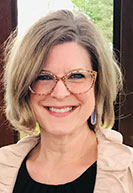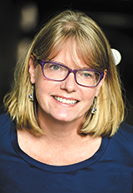Subscriber Benefit
As a subscriber you can listen to articles at work, in the car, or while you work out. Subscribe Now
Many donors who support Indianapolis arts organizations are asking the same question during a time of significant turnover in leadership: “Are things going to change?”
“No, but also yes,” is an appropriate answer, according to Kathryn Haigh, the new CEO of the Eiteljorg Museum of American Indians and Western Art. The Eiteljorg is one of nine high-profile area arts organizations that are making changes or have made changes at the top since October 2021.
Haigh succeeded John Vanausdall, who retired in June after more than 26 years at the museum. Signature Eiteljorg events such as the Quest for the West art show and Indian Market & Festival will remain as fixtures on the museum’s calendar, Haigh said.
“There are so many great foundational programs that John and the team here have built that will not go away,” said Haigh, previously chief operating officer at Newfields, another of the arts organizations that hired a new CEO during the past two years. “We’re quick to assure people that those won’t change, but they may evolve a little bit.”
Such assurances can matter to the organizations’ regular donors, who have often bought into a previous leader’s vision. But change and growth are also important as new leaders look to attract new donors.
Museums and theaters rely on individuals to provide support through memberships, subscriptions and monetary gifts. Grants and corporate partnerships represent major revenue sources for not-for-profits, while tickets sold for performances or single-day visits make up a smaller part of the equation.

Frank Basile, a leading arts philanthropist with his wife, Katrina Basile, is experienced at giving as well as seeking funds. His career includes stints as interim top executive for Heartland Film and Carmel’s Center for the Performing Arts.
“Attracting donations is the lifeblood of an organization, because most organizations cannot make it through [solely] charging for their services,” Basile said. “They can’t charge enough. If they did charge enough, not enough people could take advantage of it.”
The importance of contributed income is evident in the contrast between ticket revenue and operating budgets. In 2022, the Indiana Repertory Theatre sold $1.6 million in tickets while conducting business on a $6.4 million budget. The Phoenix Theatre Cultural Centre sold $136,227 in tickets in 2022, when the organization’s operating budget was $1.3 million.
But even as contributions outweigh ticket sales, economic conditions are shrinking the value of benefactors’ gifts.
Total U.S. charitable giving declined in 2022, according to a new report on philanthropy published by the Giving USA Foundation and researched and written by the Indiana University Lilly Family School of Philanthropy.
“Giving USA 2023: The Annual Report on Philanthropy for the Year 2022” cited $319 billion in giving by individuals, representing a 6.4% decrease from 2021. When adjusted for inflation, the decrease was 13.4%.

In the area of giving to arts, culture and humanities, individual donations increased in 2022, but inflation knocked down the value. The Giving USA report indicated that individual donations to the arts, culture and humanities sector grew 2.9% to an estimated $25 billion. When adjusted for inflation, the gifts represented a decrease of 8.9%.
The report published on June 20 pinpointed stock market volatility and economic uncertainty as factors in the year-to-year changes.
Meanwhile, event attendance is being affected by what Indy Arts Council CEO Julie Goodman calls “the lure of the couch”—a lifestyle trait that took hold during pandemic lockdown.
“People are not making long-range plans like they used to,” Goodman said. “There’s a lot of last-minute ticket purchasing right now.”

Attracting new support
At the Eiteljorg, CEO Haigh said she’s focused on bringing new visitors to the museum and developing the next generation of donors.
The Indiana Repertory Theatre recently hired Benjamin Hanna in the role of artistic director to succeed Janet Allen, who held the position more than 27 years.
In an effort to broaden its audience, the IRT will present a full-scale musical for the first time in more than a decade. “Little Shop of Horrors” is scheduled for April 17 to May 19, 2024.

Suzanne Sweeney, managing director of the Indiana Repertory Theatre, said donors are curious about what changes will accompany Hanna’s move to artistic director after he spent five years as associate artistic director.
“He already knows a lot of the donors,” Sweeney said. “We’ve had time to do some very intentional meetings and meetups. Ben is talking about his vision for the theater and having people understand that it’s not going to be wholesale change. It will be different, but it will still be their theater.”
To coincide with Allen’s retirement, the IRT launched a $6 million capital campaign titled “Back to the Future.” With $3.5 million in commitments announced in June toward the $6 million goal, the organization will rename its Upperstage Theatre to honor Allen and make upgrades to the performance space.
Cultivating new audience members is key. Before someone donates a sizable amount of money to an arts organization, the person typically is a frequent attendee of performances or exhibitions.

That’s why a dip in ticket sales can affect charitable giving, said Bill Simmons, former artistic director and capital campaign manager at the Phoenix Theatre Cultural Centre. If attendance is down 20%, for instance, an organization is missing 20% of its potential donors.
“Suddenly, they’re not coming to the theater and it’s, ‘Well, I don’t think I’m going to give a gift this year because I’m not going.’ It’s unsettling for this sector,” said Simmons, who launched Bill Simmons Consulting LLC in 2022.
Still recovering
Goodman, leader of the Indy Arts Council, a not-for-profit that supports artists and arts organizations, said ticket revenues and subscriptions have not fully recovered to pre-pandemic levels.
“In Indianapolis, we are fortunate to have a generous community who consistently values the role of arts and culture,” Goodman said. “But it’s tough out there. Normalizing after the pandemic has been tricky. What we saw in our research and our assessments throughout the pandemic is that earned revenue was volatile and continues to be kind of wobbly.”
In June, financial woes hit theater groups in Illinois, California and Oregon. Chicago’s Lookingglass Theatre cut its full-time staff from 24 to 10 while calling off productions until next spring. The Center Theatre Group in Los Angeles canceled upcoming shows because of budget shortfalls. And the Oregon Shakespeare Festival announced a need to raise $7.3 million to complete its season.
Simmons said it’s possible Indianapolis organizations will be in peril of closure soon.
“The groups that emerge, either by making it through or by being created, are going to have a different model of operating that isn’t based on so many ticket sales and therefore so many individual donors,” he said. “You’re going to have to create something new.”
Simmons praised Ryan Artzberger, who became the Indianapolis Shakespeare Company’s executive artistic director in 2022, for expanding the troupe’s repertoire to include new plays inspired by classic works.
In February, the Indianapolis Shakespeare Company presented “Mojada,” based on ancient Greek tragedy “Medea,” at the Phoenix.
And Simmons has an acting role in the company’s production this month of “Love’s Labor’s Lost” at Taggart Amphitheatre in Riverside Park.
Simmons also complimented his former employer, the Phoenix, for unveiling a 2023-24 season in which seven different theater companies will present shows at the Phoenix building, 705 N. Illinois St., that opened in 2018.
The Phoenix is going through leadership changes, too. Constance Macy became artistic director at the Phoenix in 2022, and the organization announced in April a national search to hire a permanent CEO.
In some cases, audiences are returning.
The Indiana Repertory Theatre made a splash by closing its 2022-23 season with pop culture play “Clue.”
Sweeney said the IRT set a ticket goal for “Clue” higher than any production aside from the theater’s annual holiday run of “A Christmas Carol.” “Clue” was inspired by the board game and adapted from the 1985 film starring Tim Curry.
Audiences responded by sending “Clue” 60% above the goal for ticket sales, Sweeney said.
“People will engage with things that are exciting to them,” she said.
Arts as an investment
But not every show is a smash hit, which leaves organizations operating in a mode of “survival economics,” Goodman said.
Philanthropy is valuable for its support of efforts in innovation and experimentation.
“Like any startup, we need investors,” Goodman said. “We need investors to help us define this next chapter of relationships and audience. If donors can think of themselves as venture capitalists and as investors, that’s the model we need to think about and emulate in a lot of ways.”
And while profits won’t come back to this type of “venture capitalist,” the return can be a healthy cultural community.
Basile, a retired Gene B. Glick Co. executive who serves on the Indy Arts Council board of advisers, is just that kind of arts venture capitalist. He and his wife have given enough to earn naming rights for more than 10 local theaters.
He’s also been part of the arts community long enough to have watched plenty of leadership changes. And Basile said he’s encouraged by the hirings of Haigh at the Eiteljorg and Hanna at IRT, as well as the transition from David Hochoy to Joshua Blake Carter in the role of artistic director at Dance Kaleidoscope following Hochoy’s retirement.
The Basiles plan to continue their financial support of the Eiteljorg, IRT and Dance Kaleidoscope.
Basile also said he intends to continue backing the Central Indiana Community Foundation and The Indianapolis Foundation following the June retirement of Brian Payne. Jennifer Bartenbach will succeed Payne as CEO of the CICF, while Lorenzo Esters will succeed Payne as president of The Indianapolis Foundation. Both foundations award grants to not-for-profits.
“When we make the decision to contribute, we consider the mission of the organization followed by the length and degree of our involvement and, thirdly, the confidence we have in the leadership—especially the CEO,” Basile said of the couple’s decision-making process.
Basile cites multiple ways a CEO can build relationships with donors, including in-person visits, special events, phone calls, letters and emails.
He recalls being asked to make his first major gift to an arts organization—$30,000 in the 1980s to help build the Indianapolis Art Center building at 820 E. 67th St. Basile said he was persuaded to say “yes” by the organization’s commitment to community outreach initiatives.
Nearly four decades later, Basile said he continues to receive personalized updates related to outreach efforts by the organization.
“It’s important that a donor doesn’t feel they give their money and they’re history until the next year when they’re asked for money again,” Basile said.
Vanausdall, the Eiteljorg’s former CEO, had that kind of touch with donors—and the museum recently completed its $55 million Project 2021 campaign, which included raising $40 million in cash and pledges for the museum’s endowment.
Vanausdall “was a very genuine personality, and he was very warm with our donor base,” said Nataly Lowder, the Eiteljorg’s vice president for advancement. “I’m seeing that trait in [Haigh] already, just right out of the gate. People are immediately enjoying her, and I just think that that’s going to bode well for the Eiteljorg long term.”
The museum’s development team consists of six staff members, including the CEO. Roles on the team are devoted to memberships, grants and corporate partnerships.
Haigh assumed her duties at the Eiteljorg in May, meaning she worked alongside Vanausdall until his retirement at the end of June.
In Haigh’s initial weeks as CEO, she reached out to donors who support both the Eiteljorg and Newfields, where she worked from 2007 until this year. Haigh said she also tried to meet as many people as possible, with events celebrating Vanausdall’s retirement serving as a fruitful environment.
“Those have been amazing opportunities to get to know members of the board,” Haigh said. “I’ve also worked closely with Nataly and John to identify donors I need to get in front of, and I’m making plans to fly out to see donors who are not in Indianapolis.”
Leaders should also ask their board members to refer potential donors who are friends and business associates, Basile said.
“Board members are an important link to resources for your organization,” he said. “Responding to these requests for assistance is part of the job description for board members.”
New opportunities

Tamara Winfrey-Harris, who previously worked in the communications departments of the Eiteljorg and Chicago’s Museum of Science and Industry, was hired in December as president of the Women’s Fund of Central Indiana—a special interest fund of the Central Indiana Community Foundation.
Winfrey-Harris said she views the current era of leadership transitions as a chance for supporters to make themselves heard.
“I would encourage donors and supporters, as you walk in the doors of museums and you sit and watch the plays, to take this opportunity to reach out to the organizations,” Winfrey-Harris said. “There are going to be new leaders who are open to hearing from you and need to hear from you in order for them to choose a direction for the organization.”
Although celebrated leaders Vanausdall, Allen, Hochoy and Payne have retired, Winfrey-Harris said she doesn’t anticipate an exodus of donors from any organization.
“I like to believe the donors and funders in central Indiana aren’t funding these things because of personalities—although they were fantastic leaders—but because arts and culture matter to them,” Winfrey-Harris said. “I think they will continue to do that.”
Simmons said he witnessed donor loyalty for the Phoenix when the organization launched its $6 million Ignite Passion & Purpose sustainability campaign in 2022.
“There are some gifts that were made to this campaign that far surpass what were made to the campaign that built the Phoenix” structure on Illinois Street, Simmons said. “It was a situation of, ‘OK, Bill’s leaving. We’re excited about the future.’”
Winfrey-Harris said when she moved from Chicago to Indianapolis in 2004, the central Indiana arts community made a good impression, thanks to its collaborative and collegial nature.
“People viewed each other not just as competitors but as potential partners, which is something I think donors enjoy,” she said. “With all of the transition that’s happening around the city, I hope we retain that spirit of working together to create a robust arts and cultural landscape in Indianapolis.”
For example, during Basile’s time as interim CEO for the Center for the Performing Arts, he struck a deal with the Indianapolis Symphony Orchestra for a performance with iconic violinist Joshua Bell at Carmel’s Palladium venue in 2011.
Bell already had two nights with the ISO on his schedule at Hilbert Circle Theatre, and the Palladium show happened the night before those dates.
Although Basile remembers some expressing concerns that the newly opened Palladium would take away business and patrons from the Hilbert, all three shows sold out. Former Indianapolis Symphony Orchestra CEO Simon Crookall wrote to subscribers that the Palladium show delivered contact information for 1,600 potential patrons.
“To me, that said ‘The center is not hurting other organizations, but helping them. They’re all going to do better,’” Basile said. “We still don’t have a very high percentage of people who attend arts events. The best way to do it is to increase the number who attend, and everybody’s going to benefit.”
Simmons encourages organizations to be transparent about financial challenges, including the fact that ticket purchases cover only a fraction of what it costs to produce shows and exhibitions.
“We have to tell our stories, and we have to say we can no longer do this for dimes on the dollar,” Simmons said. “We need the dollar.”•
Please enable JavaScript to view this content.


